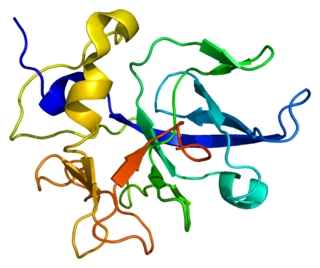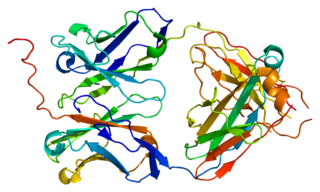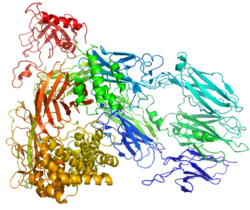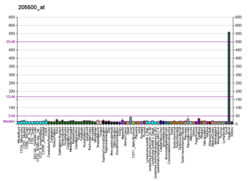
Anaphylatoxins, or complement peptides, are fragments that are produced as part of the activation of the complement system. Complement components C3, C4 and C5 are large glycoproteins that have important functions in the immune response and host defense. They have a wide variety of biological activities and are proteolytically activated by cleavage at a specific site, forming a- and b-fragments. A-fragments form distinct structural domains of approximately 76 amino acids, coded for by a single exon within the complement protein gene. The C3a, C4a and C5a components are referred to as anaphylatoxins: they cause smooth muscle contraction, vasodilation, histamine release from mast cells, and enhanced vascular permeability. They also mediate chemotaxis, inflammation, and generation of cytotoxic oxygen radicals. The proteins are highly hydrophilic, with a mainly alpha-helical structure held together by 3 disulfide bridges.

C5 convertase is an enzyme belonging to a family of serine proteases that play key role in the innate immunity. It participates in the complement system ending with cell death.

C5a is a protein fragment released from cleavage of complement component C5 by protease C5-convertase into C5a and C5b fragments. C5b is important in late events of the complement cascade, an orderly series of reactions which coordinates several basic defense mechanisms, including formation of the membrane attack complex (MAC), one of the most basic weapons of the innate immune system, formed as an automatic response to intrusions from foreign particles and microbial invaders. It essentially pokes microscopic pinholes in these foreign objects, causing loss of water and sometimes death. C5a, the other cleavage product of C5, acts as a highly inflammatory peptide, encouraging complement activation, formation of the MAC, attraction of innate immune cells, and histamine release involved in allergic responses. The origin of C5 is in the hepatocyte, but its synthesis can also be found in macrophages, where it may cause local increase of C5a. C5a is a chemotactic agent and an anaphylatoxin; it is essential in the innate immunity but it is also linked with the adaptive immunity. The increased production of C5a is connected with a number of inflammatory diseases.

Granzyme A is a tryptase and is one of the five granzymes encoded in the human genome. In humans, GzmA is encoded by the GZMA gene in proximity to the GZMK gene on chromosome 5. This enzyme is present in cytotoxic T lymphocyte (CTL) granules.

CD11c, also known as Integrin, alpha X (ITGAX), is a gene that encodes for CD11c.

The C3a receptor also known as complement component 3a receptor 1 (C3AR1) is a G protein-coupled receptor protein involved in the complement system.

Complement receptor type 2 (CR2), also known as complement C3d receptor, Epstein-Barr virus receptor, and CD21, is a protein that in humans is encoded by the CR2 gene.

The C5a receptor also known as complement component 5a receptor 1 (C5AR1) or CD88 is a G protein-coupled receptor for C5a. It functions as a complement receptor. C5a receptor 1 modulates inflammatory responses, obesity, development and cancers. From a signaling transduction perspective, C5a receptor 1 activation is implicated in β-arrestin2 recruitment via Rab5a, coupling of Gαi proteins, ERK1/2 phosphorylation, calcium mobilization and Rho activation leading to downstream functions, such as secretion of cytokines, chemotaxis, and phagocytosis.

Chymase is an enzyme that in humans is encoded by the CMA1 gene.

Bradykinin receptor B1 (B1) is a G-protein coupled receptor encoded by the BDKRB1 gene in humans. Its principal ligand is bradykinin, a 9 amino acid peptide generated in pathophysiologic conditions such as inflammation, trauma, burns, shock, and allergy. The B1 receptor is one of two of G protein-coupled receptors that have been found which bind bradykinin and mediate responses to these pathophysiologic conditions.

C5a anaphylatoxin chemotactic receptor 2 is a protein that in humans is encoded by the C5AR2 gene. It's a complement component G protein-coupled receptor, of class A (rhodopsin-like).

Aminoacyl tRNA synthetase complex-interacting multifunctional protein 1 is a protein that in humans is encoded by the AIMP1 gene.

Immunoglobulin lambda-like polypeptide 1 is a protein that in humans is encoded by the IGLL1 gene. IGLL1 has also recently been designated CD179B.

Inter-alpha-trypsin inhibitor heavy chain H2 is a protein that in humans is encoded by the ITIH2 gene.

Complement factor H-related protein 1 is a protein that in humans is encoded by the CFHR1 gene.

Transcription factor 7 is the gene that in humans encodes for the TCF1 protein.

Carboxypeptidase N catalytic chain is an enzyme that in humans is encoded by the CPN1 gene.

HLA class II histocompatibility antigen, DX beta chain is a protein that in humans is encoded by the HLA-DQB2 gene.

CD79b molecule, immunoglobulin-associated beta, also known as CD79B, is a human gene.

Formyl peptide receptor 1 is a cell surface receptor protein that in humans is encoded by the formyl peptide receptor 1 (FPR1) gene. This gene encodes a G protein-coupled receptor cell surface protein that binds and is activated by N-Formylmethionine-containing oligopeptides, particularly N-Formylmethionine-leucyl-phenylalanine (FMLP). FPR1 is prominently expressed by mammalian phagocytic and blood leukocyte cells where it functions to mediate these cells' responses to the N-formylmethionine-containing oligopeptides which are released by invading microorganisms and injured tissues. FPR1 directs these cells to sites of invading pathogens or disrupted tissues and then stimulates these cells to kill the pathogens or to remove tissue debris; as such, it is an important component of the innate immune system that operates in host defense and damage control.



























